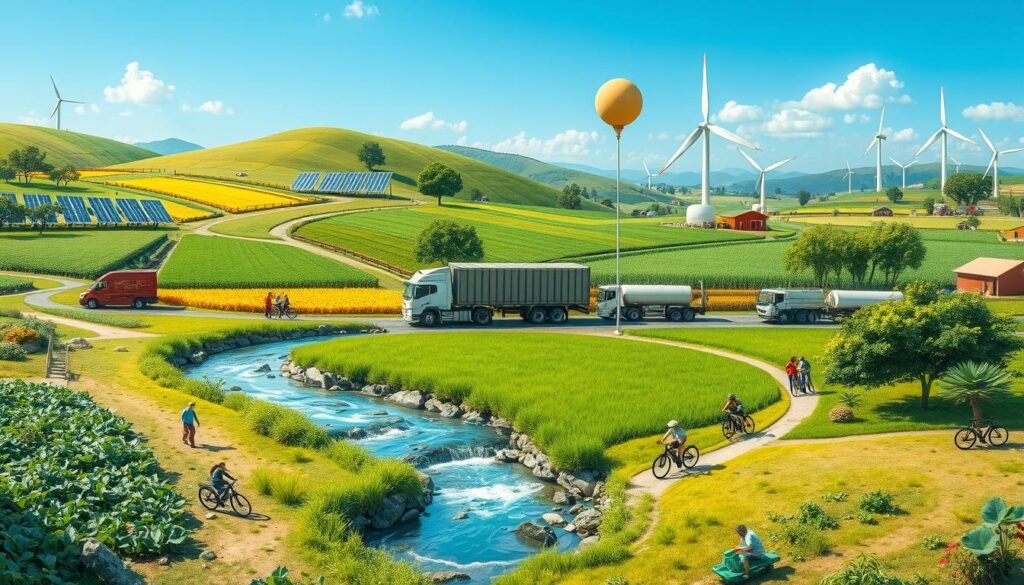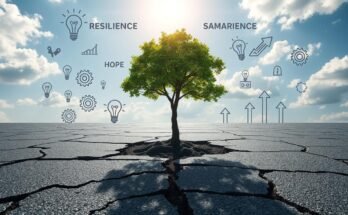As an entrepreneur or business leader, making a sustainable business that mixes profit with purpose is key. By putting sustainability at the heart of your business, you help your community and the planet. You also make sure your business can keep going for a long time.
The secret to finding this balance is a mix of several things. These include your company’s purpose, how you do business sustainably, talking to your stakeholders, managing your supply chain responsibly, innovating your products and services, measuring your performance, and thinking long-term.
Sustainability is now a big deal in business. It’s not just a trend. It’s essential for success in today’s market. When you link your company’s purpose with sustainable values, you meet the growing need for eco-friendly and socially responsible products and services.
Adding sustainability to your business model can also save you money, make things more efficient, and build stronger customer loyalty. This can really help your business grow.
Table of Contents
Defining Your Company’s Purpose
In today’s business world, having a clear business purpose is key for success. It’s not just about making money. It’s about making a difference in social impact and environmental issues. Your actions should match your values-driven beliefs.
Identify Social or Environmental Issues
First, pick the social or environmental issues your business can help with. This could mean helping those in need, being eco-friendly, or supporting causes you care about. By focusing on these areas, you make your purpose clear to everyone involved.
Align Actions with Values
After choosing the issues, make sure your business actions match your values-driven principles. This makes trust grow, keeps employees engaged, and shows you’re serious about making a difference.
A purpose-driven approach is more than just marketing. It’s about building a business that’s good for the planet, people, and profits. By setting a clear purpose and acting on it, you open up new growth chances and add lasting value for everyone involved.
“The sustainability of our planet, the diversity of our communities, and the health of our people must be at the heart of every business decision.” – Satya Nadella, CEO of Microsoft

Incorporating Sustainability into Your Business Model
Sustainability is now key for businesses wanting to last long. By adding sustainable practices, you can lessen your environmental harm. You can also benefit from the growing need for green products and services.
Adopt Eco-Friendly Practices
First, look at your business to see where you can use sustainable business practices. This could mean using less energy, creating less waste, and finding new energy sources. Think about using LED lights, recycling, or solar power for your buildings. These eco-friendly operations cut down on pollution and save money. They also make your brand look better.
Promote Fair Labor Practices
Being sustainable is not just about the planet. Making sure fair labor is key in your business and supply chain is important. This means following labor laws, paying fair wages, and keeping work safe. By caring for your workers and partners, you build a dedicated team. You also attract customers who care about social issues.
Adding sustainability to your business plan is a big step. It helps your startup last longer and make a positive difference. By being eco-friendly and fair, you boost your reputation. You also draw in talented workers and reach more customers who want sustainable products and services.

“Sustainability is not a trend – it’s a fundamental shift in the way we do business. By embedding sustainable practices into your operations, you can protect your company’s future and contribute to a better world.”
Stakeholder Engagement and Collaboration
Working with key people like employees, customers, suppliers, and local communities is key for a sustainable business. By listening to them and using their ideas, you can create new things, improve customer ties, and grow community partnerships. This way, you build trust and make sure your business meets the changing needs and worries of your stakeholders.
Engage Employees, Customers, and Communities
Use feedback tools and check your social and environmental performance often. This helps you find where you can get better and match your actions with your values. For instance, Gojek supports its drivers well, offering flexible hours, insurance, and financial services. This has made strong bonds with its workers and boosted employee involvement.
Foster Innovation and Build Trust
Working together with stakeholders can lead to better supply chains, less emissions, and clearer sustainability reports. Companies like Swiggy use data and tech to give customers what they want, making their relationships stronger. By focusing on stakeholder engagement and innovation, you can make a business that’s sustainable and has a big impact. It meets the needs of your community partnerships and customer relationships.
| Company | Stakeholder Engagement Initiatives | Impact |
|---|---|---|
| Gojek |
| Improved employee engagement and retention |
| Swiggy |
| Stronger customer relationships and business support for partners |

“Businesses collaborating with stakeholders can identify opportunities to streamline their supply chains, reduce emissions, and improve sustainability reporting transparency.”
Responsible Supply Chain Management
Being a sustainable business means looking beyond your own walls. You need to check and manage your sustainable supply chain. Encourage your suppliers to be kind to the planet and respect workers’ rights. This makes your business better for everyone.
Being open and clear about your supply chain transparency is key. Work closely with your suppliers to keep everyone honest. This helps you keep an eye on their work and helps them get better at what they do.
Big companies are now promising to buy from suppliers who care about the planet and people. Leaders in sustainability set goals for themselves and share these with their suppliers. This helps avoid problems linked to suppliers who don’t follow the rules, especially at the bottom of the chain.
| Sustainable Supply Chain Solutions | Key Features |
|---|---|
| Green Insights (Netherlands) | Tailors unique strategies for sustainable supply chain management |
| Bizlog (India) | Offers reverse logistics services for circular supply chain management |
| Halotrade (United Kingdom) | Provides a digital trading platform with governance tools for corporates and financiers |
| Bext360 (United States) | Digitizes sustainable supply chain management, focusing on industries like coffee, seafood, and cotton |
| AETHON Engineering (Greece) | Optimizes supply chain management for sustainability through automation and intelligent systems |
To manage your sustainable supply chain well, give your procurement officers better training and rewards for choosing sustainable suppliers. Knowing about sustainable practices helps improve how you manage your supply chain. Companies should focus on being good for people, the planet, and the wallet.

“Responsible supply chain management is essential for creating a lasting, positive impact on the environment and society.”
Product and Service Innovation for Startup Sustainability
As a startup, you have a chance to make sustainability a key part of your business. By focusing on sustainable product design and innovation for impact, you can make products that meet customer needs and help the circular economy.
Consider the Entire Product Lifecycle
Think about the whole life of your products or services. Look at where materials come from, how they’re made, packaged, shipped, and what happens to them at the end. Find ways to use fewer resources, make things last longer, and make them easy to recycle. Tools like the Global Reporting Initiative (GRI) can help you keep track of your sustainability efforts.
Innovate for Positive Impact
- Find problems in society or the environment that your startup can solve with new ideas. For example, green FinTech startups are creating tools to measure how companies and funds affect the environment.
- Use the SPIRAL method to make your products more sustainable. It’s a seven-step process to add sustainability to your product development.
- Work with other companies, non-profits, and government groups to make a bigger difference. The EU Green Deal has big goals for cutting down on greenhouse gases, using clean energy, and protecting nature.
By focusing on sustainable product design and innovation for positive impact, you can set your startup up for success in the circular economy. Stay flexible, open, and always look for ways to add value without harming the environment.
Measurement, Reporting, and Transparency
As a startup focused on sustainability, it’s key to measure and report your ESG performance. Setting key performance indicators (KPIs) helps you track progress. This lets you see where you can get better and share your impact with others.
Establish Key Performance Indicators
Start by picking your sustainability metrics in environmental, social, and governance areas. These could be things like carbon emissions, water use, cutting waste, employee diversity, and following industry rules.
- Environmental metrics: Energy use, water use, managing waste, using renewable energy
- Social metrics: Looking after employees, diversity, community work, checking suppliers
- Governance metrics: Following rules, ethical supply chains, diverse boards
Demonstrate Accountability
Keep track of and share your sustainability reporting often to show you’re serious about transparency. This info helps you see what needs work and tells stakeholders about your efforts. Think about using frameworks like the Global Reporting Initiative (GRI) or the Sustainability Accounting Standards Board (SASB) to make your reports more credible and easy to compare.
“The GRI Standard is used by 73% of the world’s 250 largest companies, across more than 100 countries.”
Good measurement and reporting make your sustainable business model more credible and powerful. This draws in investors and builds trust with customers and the community.
Long-Term Thinking and Resilience
The COVID-19 pandemic has shown us the importance of thinking long-term. It has taken over six million lives worldwide. Startups need to think ahead to build strong and lasting business models.
By looking at the future, you can tackle today’s challenges and set your startup up for success. This approach helps you grow and stay strong over time.
Embrace a Long-Term Perspective
Starting a sustainable business might mean spending more upfront or making tough choices at first. But, these steps can lead to better financial health and long-term sustainability later on. It’s key to think about the triple bottom line – people, planet, and profit.
This way, you build a startup that adds value for everyone involved.
Evaluate the Triple Bottom Line
Keeping an eye on the triple bottom line means your decisions affect society and the environment, not just profits. This values-led approach boosts your business resilience. It makes your startup a leader in innovation and responsibility.
“Crises can lead to structural shifts, such as a move towards digitalization and changes in supply chains, fostering accelerated growth. The importance of a resilient stance for organizations is emphasized, focusing on the ability to anticipate disruptions rather than simply reacting to them.”
Thinking long-term and focusing on the triple bottom line helps build a profitable, sustainable, and resilient startup. This approach ensures your business creates lasting value and is ready for future challenges.
Conclusion
Making a balance between making money and doing good is a constant effort. By adding sustainability to your business plan, you help create a lasting positive impact. This approach is key for startups to succeed and tackle big social and environmental issues.
Sustainable startups lead the way in innovation and shaking up old industries. They focus on green products and sustainable supply chains. By focusing on sustainability, you help your business grow and make the world a better place.
Starting a sustainable business comes with its hurdles, but the benefits are huge. When your company’s goals match sustainable actions, you build a stronger brand. You also attract great employees and stand out in the market. Let’s work together for a greener future.



